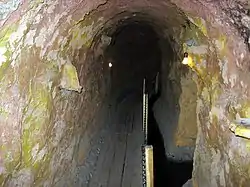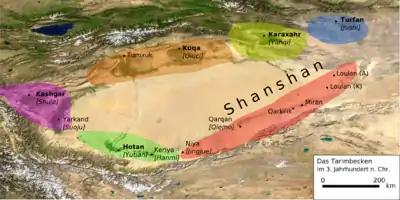
The Turpan water system or Turfan karez system Uyghur: كارىز, romanized: kariz) in Turpan, located in the Turpan Depression, Xinjiang, China, is a vertical tunnel system adapted by the Uyghur people. The word karez means "well" in the local Uyghur language.[1] Turpan has the Turpan Karez Paradise museum (a Protected Area of the People's Republic of China) dedicated to demonstrating its karez water system, as well as exhibiting other historical artifacts.
Turpan's karez well system was crucial in Turpan's development as an important oasis stopover on the ancient Silk Road skirting the barren and hostile Taklamakan Desert. Turpan owes its prosperity to the water provided by its karez well system.[2]
Description

Turpan's karez water system is made up of a horizontal series of vertically dug wells that are then linked by underground water canals to collect water from the watershed surface runoff from the base of the Tian Shan Mountains and the nearby Flaming Mountains. The canals channel the water to the surface, taking advantage of the current provided by the gravity of the downward slope of the Turpan Depression. The canals are mostly underground to reduce water evaporation and to make the slope long enough to reach far distances being only gravity fed.[3]
The system has wells, dams and underground canals built to store the water and control the amount of water flow. Vertical wells are dug at various points to tap into the groundwater flowing down sloping land from the source, the mountain runoff. The water is then channeled through underground canals dug from the bottom of one well to the next well and then to the desired destination. Turpan's karez irrigation system of special connected wells is believed to be of indigenous origin in China, perhaps combined with technology arriving from more western regions.[3][4]
In Xinjiang, the greatest number of karez wells are in the Turpan Depression, where today there remain over 1100 karez wells and channels having a total length of over 5,000 kilometres (3,100 mi). The local geography makes karez wells practical for agricultural irrigation and other uses. Turpan is located in the second deepest geographical depression in the world, with over 4,000 km2 (1,500 sq mi) of land below sea level and with soil that forms a sturdy basin.[3] Water naturally flows down from the nearby mountains during the rainy season in an underground current to the low depression basin under the desert. The Turpan summer is very hot and dry with periods of wind and blowing sand.
Importance
Ample water was crucial to Turpan, so that the oasis city could service the many caravans on the Silk Route resting there near a route skirting the Taklamakan Desert. The caravans included merchant traders and missionaries with their armed escorts, animals including camels, sometimes numbering into the thousands, along with camel drivers, agents and other personnel, all of whom might stay for a week or more. The caravans needed pastures for their animals, resting facilities, trading bazaars for conducting business and replenishment of food and water.[2]
Potential UNESCO World Heritage Site
Karez wells in the Turfan area are on the UNESCO World Heritage Sites Tentative List for China.[5]
Threatened by global warming
There are 20,000 glaciers in Xinjiang – nearly half of all the glaciers in China. The water from the glaciers via the underground channels has provided a stable water source year round, independent of season, for thousands of years.[1] But since the 1950s, Xinjiang's glaciers have retreated by between 21 percent to 27 percent due to global warming, threatening the agricultural productivity of the region.[6]
See also
- Qanat – Water management system using underground channels
- Taklamakan Desert – Desert in Xinjiang, China
- Tarim Basin – Endorheic basin in Xinjiang, China
- Cities along the Silk Road
References
- 1 2 "Karez Well". www.xj.gov.cn. Archived from the original on 2008-06-27. Retrieved 2007-09-23.
- 1 2 Boulnois, Luce (2005). Silk Road: Monks, Warriors & Merchants. Hong Kong: Odessey Books & Guides. pp. 148–149, 201. ISBN 978-962-217-721-5.
- 1 2 3 "Karez (Qanats) of Turpan, China". water history.org. Retrieved 2007-09-23.
- ↑ "The hydraulic systems in Turfan (Xinjiang)". The Silk Road. Retrieved 2016-09-06.
- ↑ Tentative list - Karez Wells
- ↑ "'Impossible To Save': Scientists Are Watching China's Glaciers Disappear". NPR.org. Retrieved 2017-10-21.

